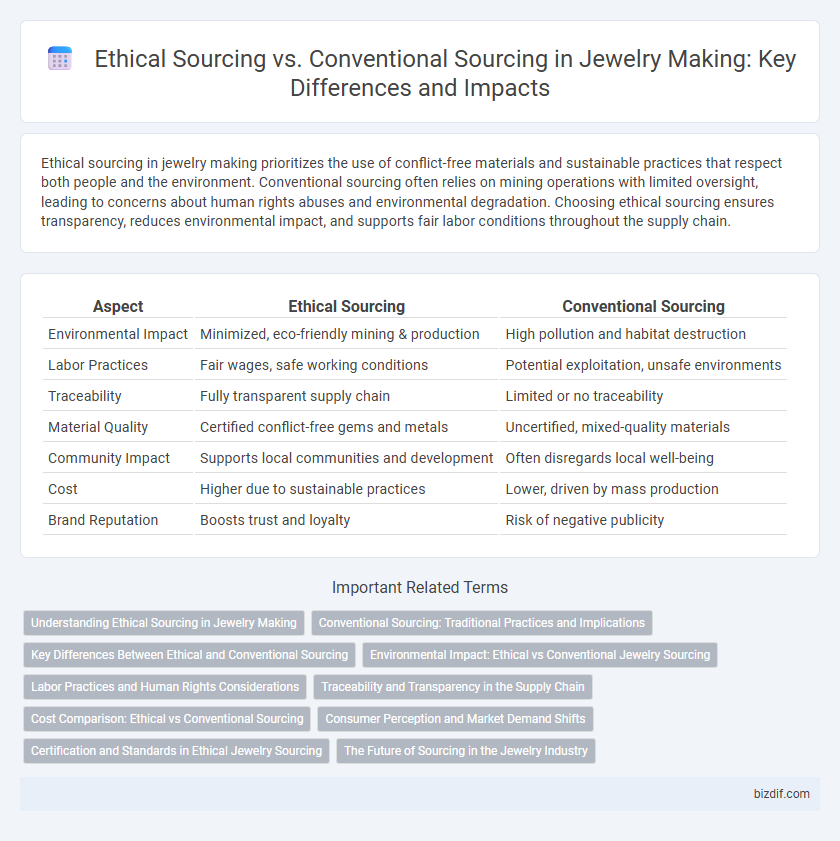Ethical sourcing in jewelry making prioritizes the use of conflict-free materials and sustainable practices that respect both people and the environment. Conventional sourcing often relies on mining operations with limited oversight, leading to concerns about human rights abuses and environmental degradation. Choosing ethical sourcing ensures transparency, reduces environmental impact, and supports fair labor conditions throughout the supply chain.
Table of Comparison
| Aspect | Ethical Sourcing | Conventional Sourcing |
|---|---|---|
| Environmental Impact | Minimized, eco-friendly mining & production | High pollution and habitat destruction |
| Labor Practices | Fair wages, safe working conditions | Potential exploitation, unsafe environments |
| Traceability | Fully transparent supply chain | Limited or no traceability |
| Material Quality | Certified conflict-free gems and metals | Uncertified, mixed-quality materials |
| Community Impact | Supports local communities and development | Often disregards local well-being |
| Cost | Higher due to sustainable practices | Lower, driven by mass production |
| Brand Reputation | Boosts trust and loyalty | Risk of negative publicity |
Understanding Ethical Sourcing in Jewelry Making
Ethical sourcing in jewelry making emphasizes obtaining materials through transparent, responsible practices that ensure fair labor conditions, environmental sustainability, and community empowerment. Unlike conventional sourcing, which often prioritizes cost and efficiency over social and ecological impact, ethical sourcing integrates strict standards such as conflict-free diamonds and recycled metals. This approach not only enhances traceability but also supports fair trade certifications and minimizes harmful environmental footprints throughout the supply chain.
Conventional Sourcing: Traditional Practices and Implications
Conventional sourcing in jewelry making relies heavily on established mining and production practices that often involve significant environmental degradation and labor exploitation. These traditional methods frequently prioritize cost-efficiency and volume over sustainability and ethical considerations, contributing to issues such as habitat destruction, pollution, and poor working conditions. The widespread use of such conventional sourcing poses challenges to the industry's shift toward more responsible and transparent supply chains.
Key Differences Between Ethical and Conventional Sourcing
Ethical sourcing in jewelry making prioritizes transparency, fair labor practices, and environmental sustainability, ensuring materials are obtained without exploitation or ecological harm. Conventional sourcing often emphasizes cost efficiency and volume, sometimes overlooking the social and environmental impacts of mining and material procurement. Key differences include the traceability of materials, the treatment of workers, and the commitment to reducing environmental damage throughout the supply chain.
Environmental Impact: Ethical vs Conventional Jewelry Sourcing
Ethical sourcing in jewelry prioritizes environmentally sustainable practices such as reduced mining waste, lower carbon emissions, and protection of biodiversity compared to conventional sourcing that often involves destructive mining, habitat destruction, and water pollution. Traceable supply chains in ethical sourcing ensure responsible material extraction and support fair labor conditions, mitigating ecological damage. Conventional sourcing frequently neglects these factors, contributing significantly to deforestation, soil degradation, and toxic chemical use, exacerbating environmental harm.
Labor Practices and Human Rights Considerations
Ethical sourcing in jewelry making emphasizes fair labor practices, ensuring safe working conditions, fair wages, and the elimination of child and forced labor, contrasting sharply with conventional sourcing where such standards are often overlooked. Human rights considerations in ethical sourcing promote transparency and accountability throughout the supply chain, fostering respect for workers' rights and community well-being. Conventional sourcing frequently neglects these aspects, leading to exploitation and environmental harm in mining communities.
Traceability and Transparency in the Supply Chain
Ethical sourcing in jewelry prioritizes traceability and transparency, ensuring every gemstone and metal originates from conflict-free mines with verifiable labor practices. Conventional sourcing often lacks comprehensive documentation, making it difficult to confirm the ethical origins of materials used in jewelry. Enhanced supply chain transparency helps brands guarantee sustainable practices and build consumer trust by openly sharing sourcing information.
Cost Comparison: Ethical vs Conventional Sourcing
Ethical sourcing in jewelry making often involves higher upfront costs due to fair labor practices, sustainable materials, and transparency in the supply chain, which can increase product prices by 10-30% compared to conventional sourcing. Conventional sourcing tends to minimize expenses through bulk purchasing and less stringent regulatory compliance, resulting in lower production costs but potential hidden environmental and social risks. Investing in ethical sourcing, despite higher costs, enhances brand reputation and meets growing consumer demand for socially responsible jewelry.
Consumer Perception and Market Demand Shifts
Consumer perception increasingly favors ethical sourcing in jewelry making, driven by heightened awareness of environmental sustainability and human rights. Market demand shows a clear shift toward responsibly sourced gemstones and recycled metals, pressuring brands to ensure transparency and certification. Conventional sourcing faces declining appeal due to associations with conflict materials and unethical labor practices.
Certification and Standards in Ethical Jewelry Sourcing
Ethical jewelry sourcing emphasizes certifications such as Fairmined, Fairtrade Gold, and Responsible Jewellery Council (RJC) to ensure materials are responsibly mined and produced under strict environmental and social standards. These certifications promote transparency, fair labor practices, and minimal environmental impact, contrasting with conventional sourcing where such standards are often absent or inadequately enforced. Compliance with recognized standards in ethical jewelry guarantees consumer confidence in the origin and sustainability of precious metals and gemstones.
The Future of Sourcing in the Jewelry Industry
Ethical sourcing in jewelry prioritizes transparency, fair labor practices, and environmentally sustainable mining, significantly reducing the industry's carbon footprint and human rights issues compared to conventional sourcing. Consumers increasingly demand traceability and conflict-free certifications, pushing brands to adopt blockchain technology and rigorous supply chain audits. The future of jewelry sourcing hinges on integrating innovative, eco-friendly materials and ethical standards to meet growing market expectations for responsible luxury.
Ethical sourcing vs Conventional sourcing Infographic

 bizdif.com
bizdif.com